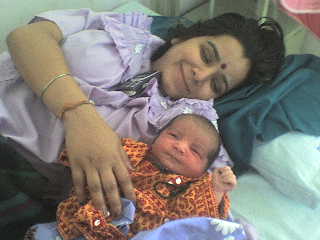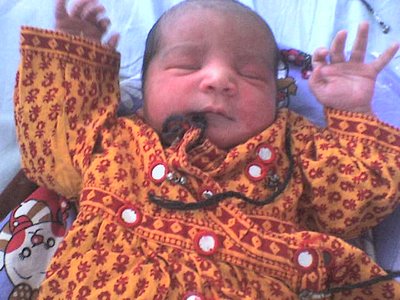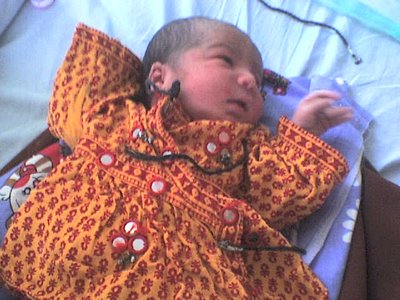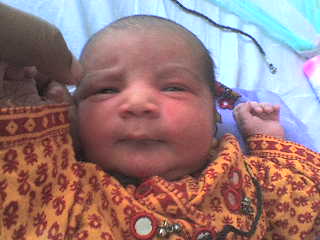Sunday, November 19, 2006
Sethi Mohalla in Peshawar
" One of the oldest parts of the city situated in the heart of Peshawar, Mohalla Sethian presents a fine series of 18th and 19th century architecture. It depicts a mixed artisanship of Bukhara, Kashmir, Golkanda and Iranian cultures.
The roofs of these palatial mansions or havelis located in Bazaar-i-Kalan are connected to each other by wooden bridges, depicting a kaleidoscopic world inside the weather-beaten, brick-walled houses. The havelis speak volumes about the aesthetic sense and love for embellishments of their once-rich occupants.
The small Kashmir bricks known as Waziri were used in the Mughal era from Lahore to Agra. The use of limestone, colourful glasswork, embossed settings of flowers on wooden doors, windows, frames, arches and columns and aroosi engraved by Bukhara artisans take any visitor to the bygone days when Peshawar was ruled by exiled Afghan princes.
Sethis were the businessmen of Peshawar. These traders earned huge profits in trade with India, Afghanistan and Central Asia. The palatial residence of the Sethis, built in 1882 by Haji Ahmad Gul, is proof of this fact.


Ahmad Hasan Dani, in his book Peshawar - Historic City of the Frontier, describes the palatial residence of the Sethis. He says: "It is a highly-embellished building in the typical style of the domestic architecture of a rich man, presenting highly-carved wooden doors, balconies, a mirrored and painted reception room with open upper storeys to catch the fresh breeze and underground rooms in two stages for protection from the summer heat. A highly-carved wooden doorway leads into a court where business was transacted.
A bent passage gives access to the interior. The main house forms round an open court, 32x30, paved with bricks. The surrounding rooms show highly-carved wooden arches resting on pillars with panels showing variegated motifs...the whole building gives an appropriate idea of the old type of houses."


The three-storey building consisting of a tehkhana, balakhana and a dalan opening through a triple-arched entrance has a colourfully-painted ceiling. An interesting feature of these buildings is the colourful ceilings designed and painted in different colours in every room. The variety in design and paint of the ceiling and colour combination is awe-inspiring.
The cut-glass fixed on the walls reflects the colourful panels embellished with antiques and vases. Hundred-year-old chandeliers in blue and yellow, imported from Belgium, enhance the beauty of the room.Muhalla Sethian would have attracted more tourists if it were open to them, but it is still inhabited by the Sethis and the beauty and grandeur is inaccessible to the public. This old and historic Muhalla should be preserved."
and another one i got hold of was the following one which talks about some Karim Baksh Sethi and his palatial house :
"... Sethian Street is very wide and less winding as compared to other streets of the old city. The houses were built on the style of havelis with large entrance doors.
Sethi Karim Baksh’s house was built in 1900 its woodwork and walls decorated with frescoes looking like something from the other world. The Sethis had flourishing business ties with Shanghai, Kabul, Bombay, Amritsar, Karachi and Central Asian states. The socialist revolution of 1917 reversed their fortunes, and their millions in Russian currency became worthless overnight. They built spacious havelis for their families and participated in a lot of public welfare activities. Between Gorekhatri and Ghanta Ghar, there used to be a huge well of cold water known as Sethi Karim Baksh Well. It had many spools for pulling up water. In the scorching heat of Peshawar, passersby used to drink the sweet and cold water from the well.
and yet another article which talks about the great havelis that were present in the Sethi Mohalla and presumable bad state they are in currently
"Peshawar is one of the ancient cities of Pakistan and the sub-continent. The Havelis of Mohalla Sethian in Peshawar represent exquisite architecture. Though many of them have been destroyed due to the apathetic attitude of the people towards the heritage value, some of them could still be saved.
Built across narrow streets, these Havelis used to be the abodes of the affluent businessmen of yore from the Sethi family. For nearly 2000 years, these narrow streets have shown no change except for the fact that these streets can no longer cope with the modern vehicles. Sethis carried their merchandise from India to China to Central Asia. Successful merchants as they were, they built eight big, beautiful Havelis in the 18th century. They retain the old world charm to this day with lot of timber going into their construction. The Sethi family originally hailed from Chamkani where they originally built houses on several kunals of land. Though several of them have been deserted for long by families who have shifted to more upmarket areas of the city, they are worth preservation. Neglect and apathy have pushed several of them to the verge of disaster. One of these large mansions has now been turned into a furniture -making unit.





Says Suhail Sethi, their ancestors were fond of building grandiose mansions. They even built several mosques and the Islamiah College of Peshawar. Almost every such mansion used to have a 'Cheenikhana' where chandaliers, lamps and crockery from Samarkhand and Bukhara were displayed in shelves. These havelis followed the same broad pattern of two-storeyed structures raised around fountains and a large central court-yard. Every plank, pillar and bracket was carved with hand. According to furniture maker Mukarram Khan, such carving is not possible today.
Each Haveli used to have a basement where according to elders, one needed a blanket to wrap while sleeping even in the hottest summer. The precious architectural heritage today urges immediate steps to save the remaining vestiges of the past. Citizens of Peshawar have urged the members of the Sethi family to chalk out a plan to preserve the heritage for the future."
Labels: peshawar, sethi mohalla
Tuesday, October 31, 2006
New Addiditon to Sethi Family
 Yesterday Sethi family was blessed with a beautiful baby boy.....!!
Yesterday Sethi family was blessed with a beautiful baby boy.....!!Aadi was born on 30 Oct 2006 to my eldest sister Jyoti and my brother-in-law Vivek.
Here are some snaps of one day old Aadi




More snaps of dear Aadi are on http://picasaweb.google.com/dsethi/Aadi
Sunday, October 01, 2006
The Family Tree

My grandfather Late Sh. Harnarayan Sethi used to deal in dry fruits in District Rawalpindi (now in Pakistan). They used to have a house in Pindi Gheb. During the partition of India in 1947 he had to migrate to India. He locked all the money he had in some trunks at home and carried with himself just few ledgers thinking that soon he will be able to get back home. But that day never came.
My grandfather and grandmother came to India and settled in Ambala City in a house that was allocated to them by the Indian Government. It is believed that the house we got then was earlier occupied by muslims who had now fled to Pakistan. The neighboring houses had similar stories too.
My grandparents had to deal with a lot of hardships during their life. They had lost everything they had in Pakistan and they started life anew in India. My grandfather tried his hands in starting business of cotton , selling goat milk and also keeping chicken among many other things. But luck was not on our side and none of these businesses really flurished. After sometime he got a job with the Electricity Board as the meter reading collection man. Along with the job he and my grandmother used to make Paper envelopes at home during night to make the ends meet. They used to sell these envelopes to grocery stores to get some money.
My father was a small baby at the time of partition. Two other sons were born to my grandparents in India. My father and his brothers used to go to a government school during the daytime and used to help their parents at night by making the paper envelopes.
With the passing of time the family situation improved. My father and his brothers were able to go the S.A.Jain public school which was known to be a good school in town. My father got admitted to the Polytechnic Institue and got a diploma in mechanical engineering from there. After completing his diploma my father got a job with the sugar mills at Jagadhari. His younger brother Avinash got admitted to Indian navy. This was an achievement in itself for the family considering the hardships they went through.
In 1972 my father got married. My mother was the daughter of an acquaintance of my grandfather. My maternal grandparents knew my grandparents from back in Pakistan. The y too had migrated to Ambala after partition.
After marriage my mother stayed with my grandparents at Ambala whereas my father used to live in Pune/Jagadhari/Delhi etc. because his job was not yet permanent. My father used to visit home quite often so i understand that this was not a major problem. And also i think things were different back then.
In 1975 we lost my grandfather and being the eldest son of the family the responsibilty of the family came on the shoulders of my father. He along with his younger brother Avinash took care of all the expenses of the family. They both ensured that the youngest brother Goverdhan completed his B.Sc. They also got the house in Ambala renovated and built another storey to it.
In 1975 my father's younger brother Avinash also got married. He got married to daughter of anand family. Our family had met that family at the time of performing the last rites of my grandfather. It is said that my grandfather and Harsh's father both died on the same date.
In 1976 my eldest sister was born to my parents. According to my grandmother she was the first girl in the Sethi Family after a very long time and hence her birth was celebrated with full fun and frolic.
In 1979 my elder sister Geeta was born. She was lucky for our family because just after her birth my father got a permanent job with Ministry Of Defence, Govt. of India and this made things lot smoother for the family. We were able to get our house at Ambala renovated and also built up another storey to the house.
Just 6 days after Geeta's birth , Avinash Uncle was also blessed with a boy - Gagan.
After completing his B.Sc. my father's youngest brother Goverdhan decided of following the footsteps of my grandfather and started to learn automobile business from some of the family's close relatives.
In 1980 i was born to my parents and my birth was also celebrated with full frolic as i was born after two consecutive girls being born to my parents. It is also said that my parents had made a wish for a boy to the Goddess Vaishno Devi whom the family has faith in. I could not get to spend much time with my grandmother because soon after my birth my father got a somewhat permanent job placement at Jabalpur and my mother soon shifted to Jabalpur. Jabalpur remained as our home for the next 16-17 years to come.
In 1980 Goverdhan uncle got married. His marriage was celebrated with quite grandeur as he was the youngest in his generation and that was going to be the last marriage for quite sometime.
In 1981 Avinash uncle was blessed with another son - Sanjeev. Also in the same year Goverdhan uncle got blessed with a son too - Jitendar.
We used to visit Ambala every summers during our school vacations from Jabalpur. We used to have lots of fun with all our cousins. It is interesting to remember all the small stupid things we used to do as a child. I remember going to play video games at a nearby parlour, my grandmother was totally against it, she used to make us rub our noses on the floor after she got to know that we had gone for playing video games. We used to make water pool inside bathroom and used to splash each other. Then there was this cleaning of the underground water tank which was so much fun, it was as if we were visiting some sort of a cave or something. I remember i once pushed Sanjeev into the water tank and he broke his nose. I think i will cover the childhood anecdotes in another blog entry.
In 1986 Goverdhan uncle was gifted with a girl - Supriya. With Supriya's birth both my father and Goverdhan uncle had atleast one girl each. But Avinash uncle had none. So it was decided (i think this is the reason i am not sure) that my elder sister geeta will stay back at ambala. She stayed at ambala for something like 2 years. For the very same reason Geeta has studied in more than 10 schools.
For health problems Avinash uncle had to leave Navy and he joined the state goverment secretariat at Chandigarh. Later he left this job also to join in Goverdhan uncle's business.
My eldest sister Jyoti completed her schooling and went on to become the most educated member of the Sethi family with an M.Sc, B.Sc and B.Ed degree to her credit. Before her Goverdhan uncle was the most educated one.
My elder sister Geeta also completed her schooling and did her B.H.Sc along with a diploma in Dress designing.
I completed my schooling and went on to get a B.Tech and M.Tech from IIT Delhi. And now am employed with Google.
Sanjeev, Gagan and Jitendar joined in their parent's business after their schooling and are now running their own shops and all.
Supriya is completing her B.E after completing her schooling.
In 2005 my eldest sister Jyoti got married. Her marriage was the first marriage in my generation of the Sethi Family as well as this was the first marriage in the family after a gap of 15 years ( that of Goverdhan uncle being the last one ) and was celebrated with the fullest fun and frolic. With her marriage Sethi Family got another son in the form of my brother-in-law - Vivek. Vivek is a master of many skills - dancing, cooking and making other laugh being few of them.
In 2005 Gagan also got married and Sethi Family got Rani as a daughter.
As of now Goverdhan Uncle and his family stay at the same house that my grandparents got after partition. Avinash Uncle lives in his own house which is also in Ambala. My parents left Jabalpur after a long stay there in 2001. From Jabalpur my father was tranferred to Hyderabad and from Hyderabad he was transferred to Dehradun. My eldest sister lives with Vivek in Dungurpur(Udaipur) where Vivek is employed as the Regional Manager for Reliance Petrol pumps. I live in Bangalore. Our family is now kind of spread across all the corners of the country.
Looking back it appears that we have come a long way and it goes without saying that we are whatever we are because of the hardwork and hardships that our grandparents went through. May God rest their souls in peace.
May God bless the family with happiness and prosperity.